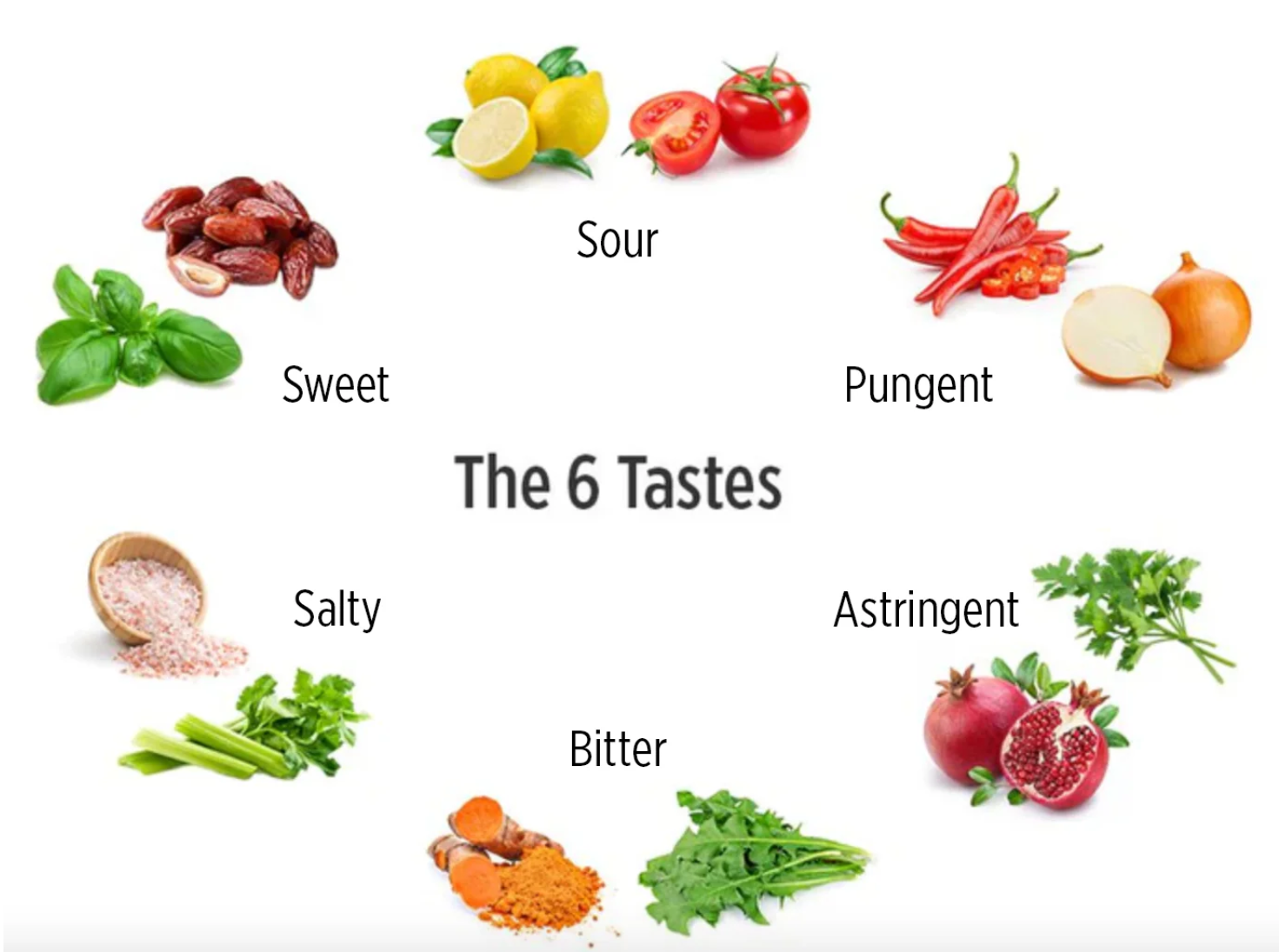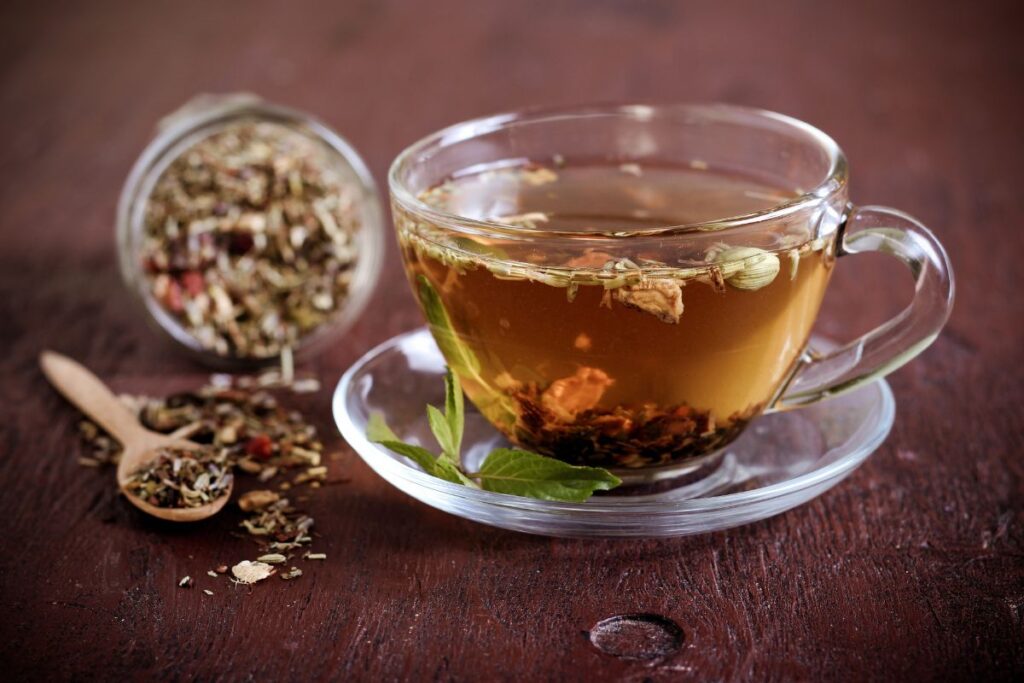Why has eating become so confusing?
I get asked every day: “Jo what should I eat? Should I fast? Keto? Low-FODMAP? Intermittent fast?” The short, brave answer from Ayurveda: stop chasing the latest FAD and learn to taste your way back to balance. The ancient system hasn’t changed because it works. It names what your body needs (your constitution and current imbalance) and how food affects you (through tastes). When you use the six tastes as your daily checklist you stop guessing and start fixing root causes instead of only suppressing symptoms with pills like antacids or laxatives.
Nothing winds me up more than seeing a well-meaning GP, naturopath or dietitian hand out the exact wrong foods for someone – because they didn’t stop to learn who that person actually is. A one-size-fits-all plan can soothe one body and seriously aggravate another. Food is information, not a blanket prescription; if we don’t ask who the person is (their constitution, imbalance, life), we risk causing more harm than help.

Imagine your body is a little house. Every time you eat, the food sends a message to that house. “I’ll warm you up”, “I’ll make you strong”, or “I’ll dry things out”. In Ayurveda, we call that message rasa (say: rah-sah), which means taste, but really it means the message food gives your body.
There are six tastes. Each taste does a different job inside your body. Here’s what they are and what they do, nice and simple.
The six tastes (what each one does)
-
Sweet – makes you feel cosy and strong. (Like: ripe banana, rice, milk.)
-
Sour – wakes up your tummy and helps food move. (Like: lemon, yoghurt.)
-
Salty – helps keep your body’s water balance and makes food tasty. (Like: sea salt, soy sauce.)
-
Pungent – is spicy and warm – it gets things moving. (Like: ginger, pepper.)
-
Bitter – cleans and cools things down. (Like: bitter greens, some herbs.)
-
Astringent – is a bit dry and tightens things up. (Like: beans, pomegranate, green tea.)
The three body types (easy names)
Think of three kinds of friends your body might be like:
-
Vata – the windy friend. Quick, bouncy, a bit chilly and dry.
-
Pitta – the fire friend. Hot, sharp and strong.
-
Kapha – the cuddly friend. Slow, soft and steady.
When one friend is too loud (out of balance), the tastes can help calm them down.
Which tastes calm for each friend
-
If you’re like Vata (windy): you feel jumpy or cold → you need more sweet, sour, and salty to feel steady.
-
If you’re like Pitta (fire): you feel hot or grumpy → you need more sweet, bitter and astringent to cool down.
-
If you’re like Kapha (cuddly): you feel slow or heavy → you need more astringent, bitter and pungent to wake up.
Why this matters
Food is not just for filling your belly, it talks to your whole body. If you keep listening to the messages (tastes), you can help your body be calm, happy and healthy. That’s why Ayurveda uses tastes; it’s a simple way to know what your body needs.
Balancing the three body types, what goes wrong, why it happens, and how taste helps fix it.
Quick refresher: what are doshas?
-
Vata = air + space. Moves things: circulation, nerves, creativity, elimination.
-
Pitta = fire + water. Transforms things: digestion, metabolism, hormone chemistry, focus.
-
Kapha = earth + water. Builds and holds things: structure, immunity, lubrication, calm.
When a dosha is in balance, you get its healthy expression (e.g. clear thinking for Vata, good digestion for Pitta, steady energy for Kapha). When it’s out of balance, you get predictable problems – and tastes work because each taste carries elements/qualities that either increase or decrease those patterns.= air + space. Moves things: circulation, nerves, creativity, elimination.
Vata – the windy mover
What Vata does well (balanced): quick thinking, lively appetite in short bursts, flexible digestion, creativity.
If Vata is imbalanced, you may see:
-
Dryness: dry skin, chapped lips, constipation.
-
Irregularity: variable appetite, erratic sleep, fiddly digestion (bloating, wind).
-
Anxiety, racing thoughts, overwhelm, and sensitivity to cold.
-
Joints may ache; menstrual irregularity.
Why certain tastes help:
Vata = cold, light, dry and mobile. Tastes that are sweet, sour and salty bring warmth, moisture, grounding and steadying effects the opposite of Vata’s qualities.
How to balance Vata:
-
Food/taste: favour warm, cooked, oily, slightly salty and sweet foods (e.g. porridge, stewed fruit, root veg, ghee). These add moisture and stability to tissues and calm nervous-system overactivity.
-
Lifestyle: regular mealtimes and sleep schedule, gentle grounding movement (slow yoga, walking), warm baths, massage with oil. These reintroduce rhythm and security.
-
What to avoid: cold/raw foods, erratic eating, excessive stimulants, very dry/crunchy diets that increase drying..
If ignored, long-term Vata excess can lead to chronic anxiety, degenerative conditions, arthritis, osteoporosis (joint wear, thinning tissues), poor sleep and poor nutrient absorption.
Pitta – the inner fire
What Pitta does well (balanced): strong digestion, sharp focus, efficient metabolism, warm body.
If Pitta is imbalanced, you may see:
-
Heat signs: heartburn/acid, skin rashes, inflammation, irritability or anger.
-
Loose stools or frequent bowel movements, strong thirst, a tendency to feel hot.
-
Perfectionism, overly critical thinking, and impatience.
Why certain tastes help:
Pitta = hot, sharp, intense. Tastes that are sweet, bitter, and astringent are cooling, calming, and slightly drying. They reduce heat and inflammation and help lower metabolic overactivity.
How to balance Pitta:
-
Food/taste: favour cooling and nourishing foods sweet fruits, bitter greens, cooling grains, mung dal and astringent elements like pomegranate and some legumes. These reduce internal heat and soothe irritated tissues.
-
Lifestyle: avoid overheating (sauna, midday sun), practise cooling breath, slower pace, regular breaks, calming routines, mindful movement (swimming, gentle walking).
-
What to avoid: excessive spicy, sour, fried or alcoholic foods, heavy stimulants, long hot showers that stoke the fire.
If ignored, ongoing Pitta excess can manifest as chronic inflammation, ulcers, skin conditions, gout, Rheumatoid arthritis, skin conditions mood volatility and faster tissue wear from ongoing heat.
Kapha – the steady builder
What Kapha does well (balanced): stable energy, strong immunity, calm temperament, good tissue reserves.
If Kapha is imbalanced, you may see:
-
Heaviness and sluggishness: weight gain, slow digestion, excess mucus, congestion.
-
Low motivation, slow thinking, fluid retention, lethargy.
-
Tendency to depression or attachment.
Why certain tastes help:
Kapha = heavy, cool, moist and stable. Tastes that are astringent, bitter and pungent are drying, lightening and stimulating. They reduce excess mucus, oiliness and sluggishness.
How to balance Kapha:
-
Food/taste: favour lighter, dryer, more stimulating foods, bitter greens, pulses in moderation, warming spices and pungent flavours (ginger, black pepper). These increase movement and metabolic action.
-
Lifestyle: energising routines (morning movement, dry brushing, invigorating walks), regular fasting windows sometimes helpful, reducing daytime naps.
-
What to avoid: heavy, oily, sugary, cold or very dairy-heavy foods and long sedentary routines.
If ignored, chronic Kapha excess can lead to obesity, diabetes, stagnation of fluids (mucus), low motivation, metabolic slowdown and increased risk for chronic damp/inflammatory conditions.
The deeper “why” – taste, elements and the body’s messaging system
-
Every taste carries elemental qualities (earth, water, fire, air, ether). Those elements create physical effects (heat, dryness, moisture, movement) and emotional tendencies (calm, irritability, sluggishness).
-
Tastes also change virya (heating/cooling effect) and vipaka (what the food becomes after digestion) – so the immediate flavour and the post-digestive effect matter.
-
Practically, you’re not choosing tastes randomly. You’re choosing signals that oppose the excessive qualities of the dosha that’s out of balance. It’s logic: opposites calm.
Simple way to check progress:
Don’t count calories, ask yourself:
-
Vata moving toward balance: more regular poos, calmer mind, better sleep, skin less dry.
-
Pitta cooling down: less heartburn, fewer skin flares, calmer temper, steady appetite.
-
Kapha getting lighter: less congestion, more motivation, easier to wake, clearer thinking.
Changes may be subtle at first taste-based shifts alter signalling, hormones, gut function and microbiome interactions. When clients grasp that small taste choices change big systems, they stop looking for quick fixes
When tastes aren’t enough
Taste-based food changes are powerful but not always a complete fix. If symptoms are severe or persistent, unexplained weight loss/gain, major sleep problems, severe digestive disease, or uncontrolled mood disorder pair taste-based care with medical tests and targeted functional support. Ayurveda is root-focused, but good clinicians use both diagnostic labs and rasa.


Responses